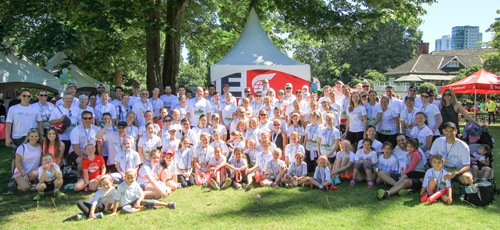Fall 2016 (Volume 26, Number 3)
Exercise is Medicine: Keeping Kids with Arthritis Active
By Kristin Houghton, MD, MSc, FRCPC, Dip Sports Med
Download PDF

The importance of physical activity (PA) to health and well-being is clear. There is a linear relationship between PA and health: those who are active and fit live longer, happier and healthier lives. However, even with common knowledge of the tremendous benefits of PA, the high prevalence of physical inactivity remains a major public-health concern. It is estimated that at least 50% of Canadian children are not active enough for optimal growth and development and 90% of children do not meet the recommended PA guidelines (60 minutes of daily moderate-to-vigorous physical activity [MVPA] with at least three days per week of vigorous-intensity activity, including activities that strengthen muscle and bone).
Exercise is medicine that everyone needs. Exercise is the ideal “drug”: it is safe, inexpensive, widely available and the “dose” can be individualized. Exercise is now considered an important part of therapy for children with juvenile idiopathic arthritis (JIA). Research has shown that exercise therapy is safe and may improve short-term clinical outcomes, function, quality of life and physical fitness. Children with active arthritis may begin with therapeutic exercises focusing on improving range of motion, neuromuscular strength and proprioception around their joints. If morning stiffness is a problem, children can exercise later in the day. Children who have inactive arthritis can participate in age-appropriate recreational and competitive athletics.
As physicians we can encourage PA and exercise. The very act of asking about PA tells the patient/family that PA is important. Physicians should ask about current PA (the exercise “vital sign”) at every visit. Studies in primary care show that a two-to-four-minute intervention can effectively promote PA. Exercise prescription follows the frequency, intensity, time (duration) and type (FITT) principle. In patients who are inactive, begin with lower-intensity PA and progress in duration and intensity over time with a goal of reaching the recommended one hour of MVPA per day. It is important to write an exercise prescription as this signals that PA and exercise is therapeutic. If a child requires individualized adaptation of the exercise prescription for a unique or complex clinical problem, referral to physical therapy or another exercise specialist is advised. Finally, it is important to follow up to chart progress, solve problems and set goals.
Exercise prescription in JIA will evolve with advances in research, and Canadian rheumatologists are leading the way. The Linking Exercise, Physical Activity and Pathophysiology in Childhood Arthritis (LEAP) study, a longitudinal observational cohort at 12 pediatric rheumatology centres across Canada (n = 709), aims to explore the relationships between JIA, physical activity, and bone and muscle development (www.leapjia.com).
As physicians, we can promote the power of exercise. I encourage you to take the PA challenge by following these three simple steps: 1) ask your patients/their family about PA at every consultation; 2) write an exercise prescription; 3) follow up to chart progress, solve problems and set goals. We can also lead by example and integrate PA and exercise into our daily lives.

“Cassie and Friends” team at the 2016 ScotiaBank Charity Challenge at the Vancouver Half-Marathon and 5K on June 26, 2016. “Cassie and Friends” is a parent advocacy group for children with juvenile arthritis and other rheumatic diseases. They were the top fundraising team for the 9th year in a row.
Kristin Houghton, MD, MSc, FRCPC, Dip Sports Med
Clinical Associate Professor,
Division of Rheumatology, Department of Pediatrics,
University of British Columbia
Vancouver, British Columbia |

